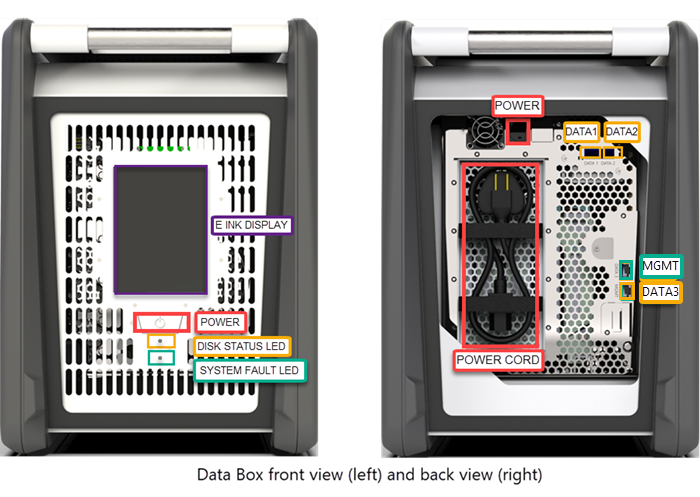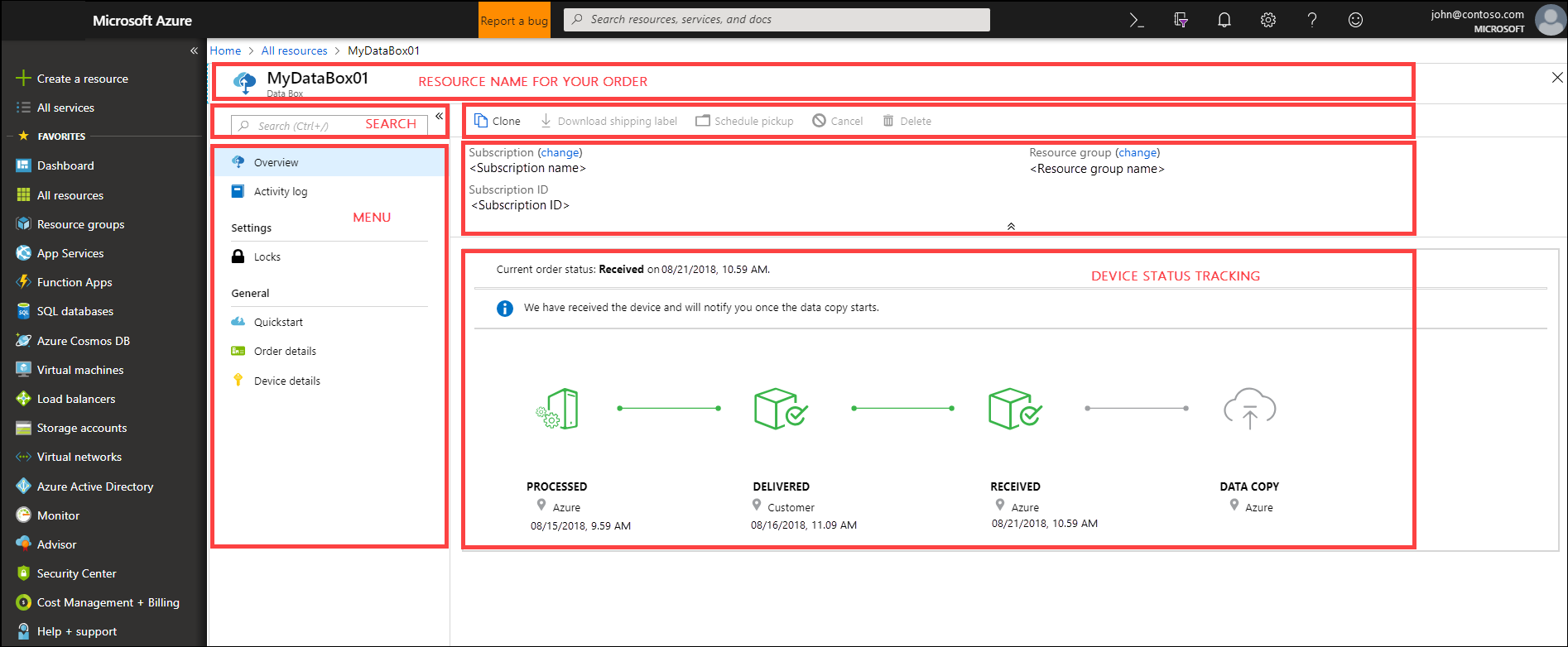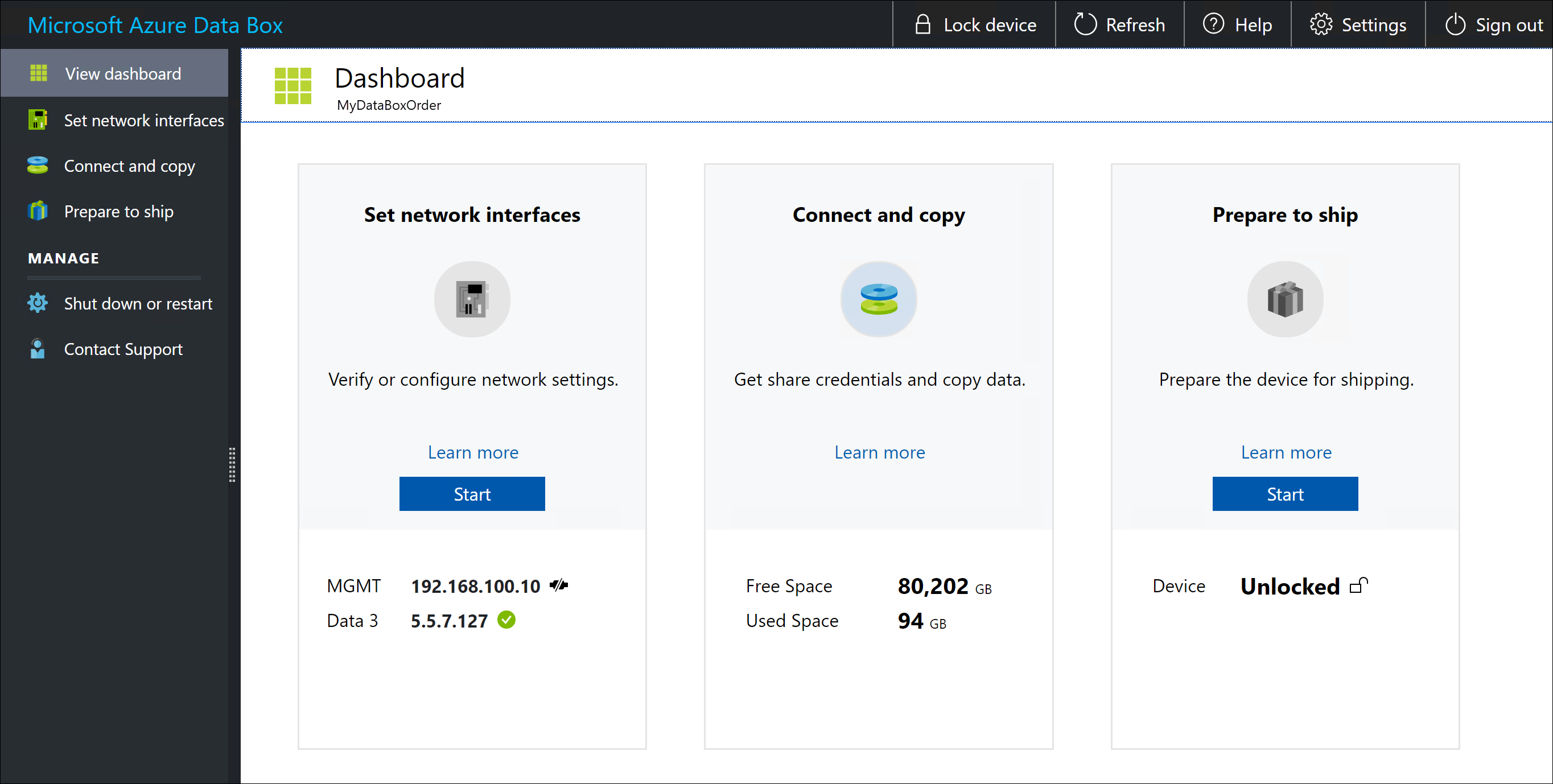Does Azure Send a Device to Pump Large Amounts of Data and Then Send to Msft for Upload
This browser is no longer supported.
Upgrade to Microsoft Border to take advantage of the latest features, security updates, and technical support.
What is Azure Data Box?
The Microsoft Azure Data Box deject solution lets y'all send terabytes of data into and out of Azure in a quick, inexpensive, and reliable way. The secure information transfer is accelerated by shipping y'all a proprietary Data Box storage device. Each storage device has a maximum usable storage chapters of 80 TB and is transported to your datacenter through a regional carrier. The device has a rugged casing to protect and secure data during the transit.
You lot can club the Data Box device via the Azure portal to import or export information from Azure. Once the device is received, you can quickly gear up information technology up using the local spider web UI. Depending on whether y'all volition import or export information, copy the data from your servers to the device or from the device to your servers, and ship the device back to Azure. If importing information to Azure, in the Azure datacenter, your data is automatically uploaded from the device to Azure. The unabridged process is tracked terminate-to-cease by the Data Box service in the Azure portal.
Use cases
Data Box is ideally suited to transfer data sizes larger than 40 TBs in scenarios with no to express network connectivity. The data movement can be one-fourth dimension, periodic, or an initial bulk information transfer followed past periodic transfers.
Here are the diverse scenarios where Data Box can be used to import information to Azure.
-
Onetime migration - when a large amount of on-premises data is moved to Azure.
- Moving a media library from offline tapes into Azure to create an online media library.
- Migrating your VM farm, SQL server, and applications to Azure.
- Moving historical data to Azure for in-depth analysis and reporting using HDInsight.
-
Initial majority transfer - when an initial bulk transfer is done using Information Box (seed) followed by incremental transfers over the network.
- For example, backup solutions partners such as Commvault and Information Box are used to move initial large historical backup to Azure. Once complete, the incremental information is transferred via network to Microsoft Azure Storage.
-
Periodic uploads - when big amount of data is generated periodically and needs to be moved to Azure. For example in energy exploration, where video content is generated on oil rigs and windmill farms.
Here are the various scenarios where Data Box can be used to export data from Azure.
-
Disaster recovery - when a re-create of the information from Azure is restored to an on-premises network. In a typical disaster recovery scenario, a big amount of Azure data is exported to a Data Box. Microsoft then ships this Information Box, and the data is restored on your bounds in a curt time.
-
Security requirements - when yous demand to be able to export data out of Azure due to government or security requirements. For case, Azure Storage is available in The states Secret and Top Secret clouds, and you can apply Data Box to export data out of Azure.
-
Migrate back to on-bounds or to another deject service provider - when you lot want to move all the data back to on-premises, or to another cloud service provider, export information via Information Box to drift the workloads.
Benefits
Data Box is designed to motion large amounts of information to Azure with little to no impact to network. The solution has the following benefits:
-
Speed - Data Box uses 1-Gbps or 10-Gbps network interfaces to move upwards to 80 TB of data into and out of Azure.
-
Secure - Data Box has built-in security protections for the device, data, and the service.
-
The device has a rugged casing secured by tamper-resistant screws and tamper-evident stickers.
-
The data on the device is secured with an AES 256-fleck encryption at all times.
-
The device tin can just exist unlocked with a password provided in the Azure portal.
-
The service is protected by the Azure security features.
-
Once the data from your import order is uploaded to Azure, the disks on the device are wiped clean in accordance with NIST 800-88r1 standards. For an export order, the disks are erased once the device reaches the Azure datacenter.
For more information, go to Azure Information Box security and data protection.
-
Features and specifications
The Information Box device has the following features in this release.
| Specifications | Description |
|---|---|
| Weight | < 50 lbs. |
| Dimensions | Device - Width: 309.0 mm Height: 430.4 mm Depth: 502.0 mm |
| Rack space | vii U when placed in the rack on its side (cannot be rack-mounted) |
| Cables required | 1 10 power cable (included) two RJ45 cables (not included) 2 Ten SFP+ Twinax copper cables (non included) |
| Storage capacity | 100-TB device has 80 TB or usable capacity after RAID five protection |
| Power rating | The power supply unit is rated for 700 W. Typically, the unit draws 375 W. |
| Network interfaces | 2 X 1-GbE interface - MGMT, Information 3. MGMT - for management, not user configurable, used for initial setup DATA3 - for data, user configurable, and is dynamic by default MGMT and Information 3 tin can also piece of work as x GbE 2 X 10-GbE interface - Data 1, Data two Both are for information, can be configured equally dynamic (default) or static |
| Information transfer | Both import and export are supported. |
| Information transfer media | RJ45, SFP+ copper ten GbE Ethernet |
| Security | Rugged device casing with tamper-proof custom screws Tamper-evident stickers placed at the bottom of the device |
| Information transfer rate | Up to 80 TB in a day over a 10-GbE network interface |
| Direction | Local web UI - ane-fourth dimension initial setup and configuration Azure portal - day-to-day device direction |
Information Box components
The Data Box includes the post-obit components:
-
Data Box device - a physical device that provides primary storage, manages advice with cloud storage, and helps to ensure the security and confidentiality of all data stored on the device. The Data Box device has a usable storage capacity of 80 TB.

-
Data Box service – an extension of the Azure portal that lets you manage a Data Box device from a web interface that yous can access from dissimilar geographical locations. Utilise the Data Box service to perform daily administration of your Data Box device. The service tasks include how to create and manage orders, view and manage alerts, and manage shares.

For more information, get to Apply the Data Box service to administer your Information Box device.
-
Local web user interface – a web-based UI that is used to configure the device so that information technology can connect to the local network, and then register the device with the Data Box service. Use the local web UI besides to shut downwards and restart the Information Box device, view copy logs, and contact Microsoft Support to file a service request.

The local spider web UI on the device currently supports the post-obit languages with their corresponding linguistic communication codes:
Language Code Language Lawmaking Language Code English language {default} en Czech cs German de Spanish es French fr Hungarian hu Italian information technology Japanese ja Korean ko Dutch nl Polish pl Portuguese - Brazil pt-br Portuguese - Portugal pt-pt Russian ru Swedish sv Turkish tr Chinese - simplified zh-hans For information about using the web-based UI, go to Utilise the web-based UI to administer your Data Box.
The workflow
A typical import period includes the following steps:
-
Social club - Create an order in the Azure portal, provide aircraft information, and the destination storage account for your information. If the device is bachelor, Azure prepares and ships the device with a shipment tracking ID.
-
Receive - Once the device is delivered, cablevision the device for network and power using the specified cables. (The ability cable is included with the device. You'll need to procure the data cables.) Plough on and connect to the device. Configure the device network and mountain shares on the host figurer from where you want to re-create the information.
-
Re-create information - Re-create data to Data Box shares.
-
Return - Prepare, turn off, and ship the device dorsum to the Azure datacenter.
-
Upload - Data is automatically copied from the device to Azure. The device disks are securely erased every bit per the National Found of Standards and Technology (NIST) guidelines.
Throughout this process, you lot are notified via email on all status changes. For more information about the detailed flow, become to Deploy Information Box in Azure portal.
A typical export catamenia includes the post-obit steps:
-
Order - Create an export order in the Azure portal, provide shipping data, and the source storage business relationship for your data. If the device is available, Azure prepares a device. Data is copied from your storage account to the Information Box. Once the data copy is complete, Microsoft ships the device with a shipment tracking ID.
-
Receive - Once the device is delivered, cable the device for network and power using the specified cables. (The power cablevision is included with the device. You'll need to procure the data cables.) Turn on and connect to the device. Configure the device network and mount shares on the host computer to which you want to copy the data.
-
Copy data - Copy information from Data Box shares to the on-premises data servers.
-
Return - Ready, turn off, and ship the device back to the Azure datacenter.
-
Data erasure - The device disks are securely erased as per the National Plant of Standards and Applied science (NIST) guidelines.
Throughout the consign procedure, you are notified via email on all condition changes. For more information about the detailed flow, go to Deploy Data Box in Azure portal.
Region availability
Information Box tin transfer data based on the region in which service is deployed, the country or region y'all ship the device to, and the target storage account where you transfer the information.
For import
-
Service availability - When using Data Box for import or export orders, to go information on region availability, go to Azure products available by region.
For import orders, Data Box can besides be deployed in the Azure Government Deject. For more information, see What is Azure Government?.
-
Destination storage accounts - The storage accounts that store the data are bachelor in all Azure regions where the service is available.
Data resiliency
The Data Box service is geographical in nature and has a unmarried active deployment in one region inside each land or commerce boundary. For information resiliency, a passive case of the service is maintained in a different region, usually within the same country or commerce purlieus. In a few cases, the paired region is outside the land or commerce boundary.
In the extreme event of whatsoever Azure region being affected by a disaster, the Data Box service volition exist made available through the corresponding paired region. Both ongoing and new orders will be tracked and fulfilled through the service via the paired region. Failover is automatic, and is handled by Microsoft.
For regions paired with a region within the aforementioned state or commerce boundary, no action is required. Microsoft is responsible for recovery, which could accept up to 72 hours.
For regions that don't have a paired region within the aforementioned geographic or commerce boundary, the customer volition be notified to create a new Information Box order from a different, available region and copy their data to Azure in the new region. New orders would be required for the Brazil South and Southeast Asia regions.
For more than information, run across Business continuity and disaster recovery (BCDR): Azure Paired Regions.
Next steps
- Review the Data Box organization requirements.
- Understand the Data Box limits.
- Quickly deploy Azure Information Box in Azure portal.
Feedback
Submit and view feedback for
camfieldstims1944.blogspot.com
Source: https://docs.microsoft.com/en-us/azure/databox/data-box-overview